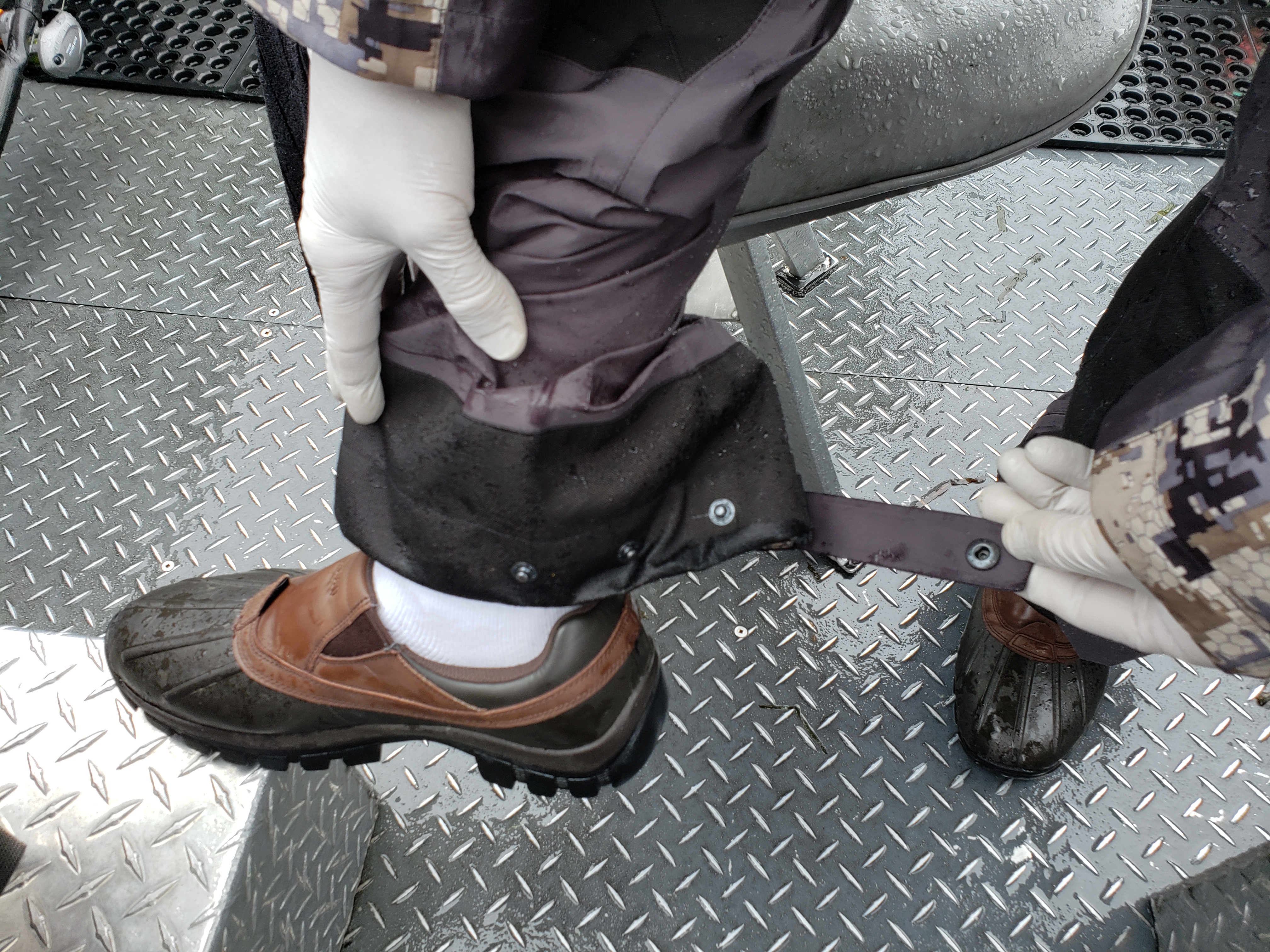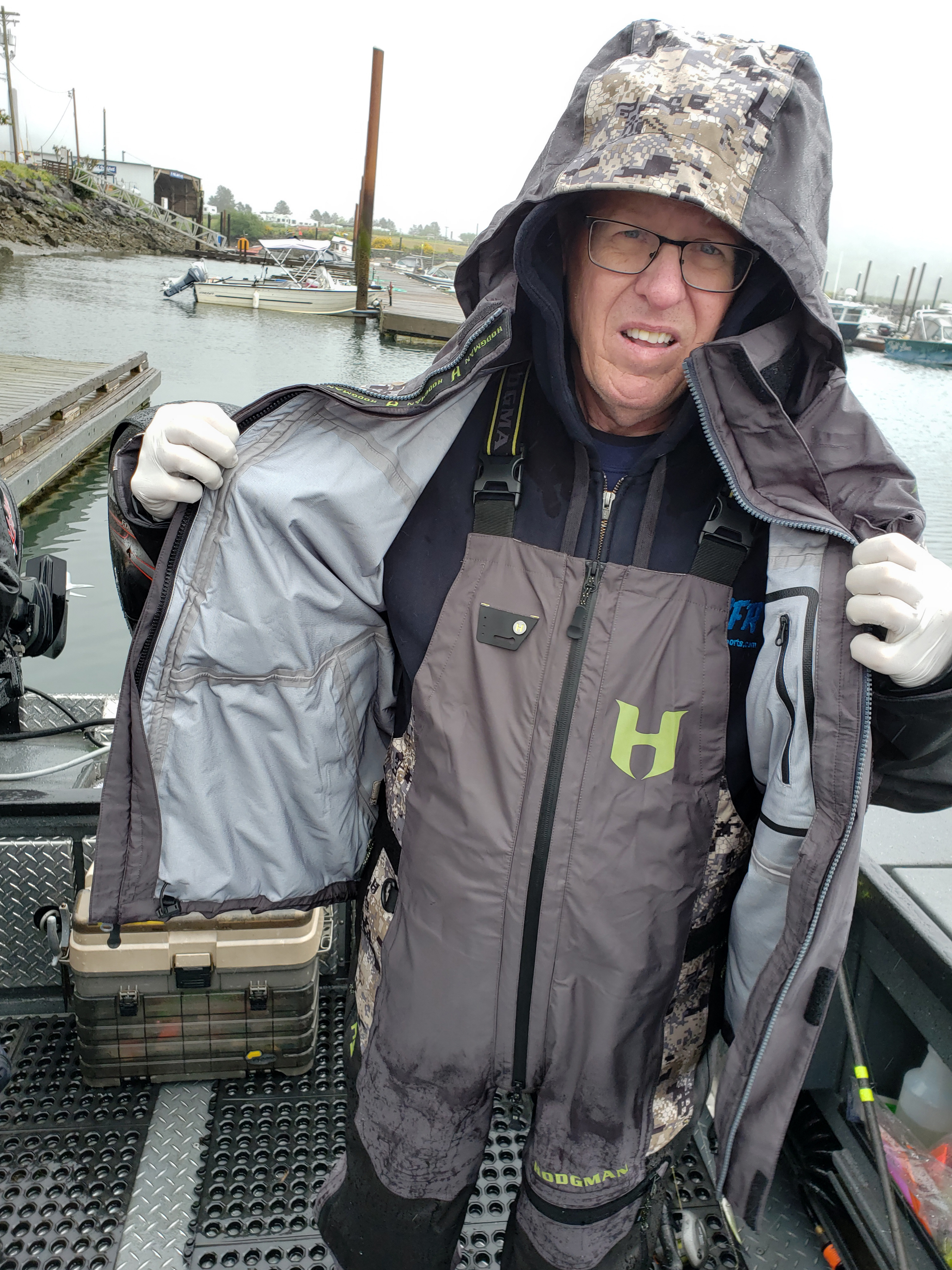Search
Latest Articles
Good Rain Gear Can Help You Catch The Big One
by Mike Carey, June 02, 2019
I’ve had my Columbia PFG rain gear for a few years now and it’s served me well, but there was always something that bugged me - the bright red color. Not that fish 40 feet under the water can see me, but it was just a psychologically thing. Added to that is the last year I’ve noted the rain gear has started to lose its rain-proof factors which obviously defeats the whole purpose of wearing rain gear. So this year I decided it was time to look around and see what other options were out there on the market for rain gear. But first, a little review of rain gear and what to look for would be useful.
My personal criteria for rain gear include (of course) the ability to hold up to our Pacific Northwest wind, rain and cold conditions. Will it keep me dry all day and allow my clothes to remain dry? To that end, prior to putting on rain gear it’s essential to start off your layers with a sound base layer garment. I’m totally sold on Gray’s Harbor Unders (Ghunders) as my first layer of warmth. Mario Winkelman, Inventor and President of Ghunders, experimented with fabrics - including wool, cotton and nylon – and found that certain evaporative cooling techniques maintain comfort in warmer temperatures as well as cool. He found a fabric that was a 4 way stretch, Polyester/Nylon/Lycra blend that was woven different than any other fabric on the market. This special fabric has two different sides, but is one piece of fabric. This dual layer fabric transports moisture from the inner layer to the outer layer keeping the skin dry even while wringing wet. I found that Ghunders make the perfect first layer for our Pacific Northwest cold, rainy, windy weather conditions. After the Ghunders, I’ll add additional layers based on how cold the day is going to be. I can always take layers off, but if I start with not enough layers I’m behind the eight ball from the beginning - not good! So my rule is, if I think I have enough layers, consider adding one more! It’s not unusual for me to have four layers of clothes before I get to my final rain gear layer.
OK, I have my layers in place. I have proper water-proof foot wear on. Now we get down to the nitty gritty – rain gear. Like most things in life, not all rain gear is equal. And depending on your budget you can spend a little or a lot. In the case of rain gear, what you pay for is definitely what you get. That said, there are things to look for when picking out your rain gear.
Material
Cheap gear generally has one or two layer material that may be waterproof like rubber, or water resistant. The trouble with this material is it has no breath-ability and it captures your body’s own moisture evaporation. So even if the gear is blocking rain your body will heat up and capture its own moisture getting you wet under the gear. One to two layer materials also tend to be at the budget end of things and construction is often mediocre, meaning over a few hours of steady rainfall you will get water leaking in at seams and finding its way round neck or arm areas. By the end of the day your layers of clothes will start getting wet, which in turn leads to you getting cold and being ready to call it a day long before you should. Unless you have no choice, avoid one and two layer outfits!
Better gear will be three layers. The outer layer will be an outer shell fabric, commonly referred to as a face fabric, which is coated with a chemical Durable Water Repellent finish to help keep the outer layer from absorbing water. The middle layer is the actual waterproof layer, The inner layer has the job of keeping sweat and oils from clogging the microscopic holes in the waterproof-breathable layer, which reduces breath-ability and causes the user to feel wet from sweat that they might think is leaking in from the rain. Just to make things a bit more confusing, there is what is called 2.5 layers, in which the inner layer is actually a “painted on”, thin layer which, while lighter, doesn’t do quite as good a job in the “breathable” department.
It’s easy to become overwhelmed with all the types of fabric and water-proofing techniques and claims that manufacturers put out. Fortunately (I think) we in the Pacific Northwest have the perfect proving grounds for purchasing our rain gear. I recommend that before you buy those expensive bibs and coats you find out what the return policy is and make sure you save the receipt. A reputable store will allow you to return rain gear that doesn’t work. The first time there is a rainy, windy day, give that gear a good test. Pay attention to fit, finish, and features. Quality gear should allow you to fish or hunt all day without getting wet and keep you warm. Of course, if you get the cheap stuff expect to get what you pay for.
Recently I got a new set of H5 Storm bibs and raincoat from Hodgman and had the perfect Northwest weather conditions to test it in. We spent the day fishing for springers with Dale Ballard of Fin Reaper Guide Service on Tillamook Bay. It was a rainy, windy, and cold day with temps in the low fifties all day. I set up my under layers starting with the Ghunders top and bottoms and then another three shirts and sweatshirts over that. The Hodgman were size large which was perfect, just big enough to allow the extra layers but not so big that I was swimming in the gear.
I was very impressed with the H5 Storm gear. The fit and finish were excellent, and attention to detail was obvious, as one would expect in a higher end set of raingear. Hodgman's branded fabric is called Cordura. The web site rates the fabric as 500 denier used to reinforce seat, knees, and sleeves. The waterproof/windproofing is advertised as a three layer fully breathable “VTech” fabric which uses a “hydrophilic membrane” advertised to pull moisture away from your body. All seams are taped which is also accounts for the excellent wind-proofing aspect of the gear. Everywhere I looked were adjustment cords to make the clothes fit to my personal dimensions. The arms have gusseted fitting, meaning when casting a rod or lifting a gun the sleeves naturally move without bunching up or binding the coat. The hood cinched down nicely and even had adjustments for my hat’s bill. The built in face mask is just an awesome feature that pretty much enclosed my head in wind-blocking goodness. Later in the day when the wind picked up I could feel the wind blowing but stayed chill free all day.
After eight hours of fishing I can honestly say it is the most comfortable fitting gear I’ve ever had.
It’s also the driest gear – it stood up to the test of eight hours of wind and rain with no water leakage whatsoever. I did have one quibble with the H5 Storm… how do I put this delicately? The center front zipper on the bib that allows guys to not have to take off their coats after drinking that 20 ounce coffee – it’s too small an opening. At 4-5” it was next to impossible for me to get to my pants and unzip them to do my business. I ended up having to take the coat off and pulling down the bib. Disappointing, but it’s not a deal breaker as all the other positives out-weighed this one negative. It’s something for Hodgman to look at when they do their next update to the bib.
Whatever rain gear you decide to purchase, my biggest piece of advice is don’t go cheap. If you make a good choice the gear should give you many seasons of comfortable fishing and hunting. Most importantly, you’ll be comfortable and dry, allowing you the endurance and energy to get that next “big one”.



